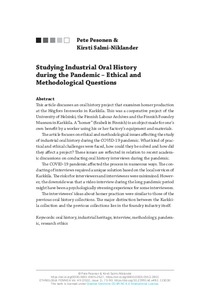Studying Industrial Oral History during the Pandemic – Ethical and Methodological Questions
Pesonen Pete; Salmi-Niklander Kirsti
https://urn.fi/URN:NBN:fi-fe2022112967902
Tiivistelmä
This article discusses an oral history project that examines homer production at the Högfors Ironworks in Karkkila. This was a cooperative project of the University of Helsinki, the Finnish Labour Archives and the Finnish Foundry Museum in Karkkila. A “homer” (firabeli in Finnish) is an object made for one’s own benefit by a worker using his or her factory’s equipment and materials. The article focuses on ethical and methodological issues affecting the study of industrial oral history during the COVID-19 pandemic. What kind of practical and ethical challenges were faced, how could they be solved and how did they affect a project? These issues are reflected in relation to recent academic discussions on conducting oral history interviews during the pandemic. The COVID-19 pandemic affected the process in numerous ways. The conducting of interviews required a unique solution based on the local services of Karkkila. The risks for interviewers and interviewees were minimized. However, the downside was that a video interview during the long pandemic period might have been a psychologically stressing experience for some interviewees. The interviewees’ ideas about homer practices were similar to those of the previous oral history collections. The major distinction between the Karkkila collection and the previous collections lies in the foundry industry itself.
Kokoelmat
- Rinnakkaistallenteet [27094]
